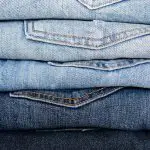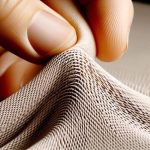Do you know what nonwoven fabrics are?
These versatile materials are not woven or knitted, but rather bonded together through various processes.
They offer unique characteristics and are widely used in a variety of applications.
Let's delve into the meaning of nonwoven fabrics and explore their defining properties, production methods, advantages, and environmental impact.
Understanding nonwoven fabrics will provide you with valuable insight into this important aspect of the textile industry.
Key Takeaways
- Nonwoven fabrics are bonded together without being woven or knitted, using processes like needle punching, thermal bonding, and chemical bonding.
- They are made from raw materials such as polyester, polypropylene, and viscose, which are processed into fibers and then laid out to form a web.
- Nonwoven fabrics have properties like high breathability, liquid repellence, and strength, and are sustainable, recyclable, and eco-friendly.
- They have a wide range of uses in industries such as healthcare, automotive, construction, and filtration, and can be customized for specific applications.
Definition of Nonwoven Fabrics
In nonwoven fabrics, a multitude of fibers are bonded together without being woven. This manufacturing process involves various techniques such as needle punching, thermal bonding, or chemical bonding.
Market trends indicate a growing demand for nonwoven fabrics due to their versatility, cost-effectiveness, and eco-friendly nature. The manufacturing process begins with the selection of raw materials, including polyester, polypropylene, and viscose, which are then processed into fibers.
These fibers are laid out to form a web, which is then bonded together using heat, chemicals, or mechanical means. The market trends show an increasing preference for nonwoven fabrics in industries such as healthcare, automotive, construction, and agriculture.
The efficiency of the manufacturing process allows for the production of nonwoven fabrics in various weights, thicknesses, and textures to meet the specific requirements of different applications. Understanding these market trends is essential for staying competitive and meeting the evolving needs of consumers in diverse industries.
Characteristics of Nonwoven Fabrics
Nonwoven fabrics have unique properties that make them suitable for a variety of uses and applications. Understanding these characteristics will help you appreciate the versatility and functionality of nonwoven fabrics in different industries.
Let's explore the specific properties and advantages that make nonwoven fabrics stand out in the textile world.
Nonwoven Fabric Properties
When considering nonwoven fabric properties, you'll find that they offer a diverse range of characteristics that make them suitable for various applications.
Nonwoven fabric innovations have led to remarkable properties such as high breathability, excellent liquid repellence, and remarkable strength. These properties make nonwoven fabrics ideal for use in medical protective clothing, ensuring both comfort and safety.
Moreover, nonwoven fabric sustainability is a key feature, as it allows for recyclability and eco-friendly disposal, contributing to a greener environment.
Additionally, the ability to be customized for specific uses and the cost-effectiveness of production further enhance the appeal of nonwoven fabrics.
With these exceptional properties, nonwoven fabrics continue to play a vital role in a wide array of industries.
Uses and Applications
Nonwoven fabrics demonstrate versatile characteristics suitable for diverse applications and uses. These fabrics are widely used in industries such as healthcare, automotive, construction, and agriculture.
In the healthcare sector, nonwoven fabrics are utilized in surgical gowns, masks, and wipes due to their excellent barrier properties and absorbency.
In the automotive industry, they're employed for insulation, upholstery, and filtration purposes.
Nonwoven fabrics offer benefits such as cost-effectiveness, lightweight construction, and ease of customization, making them ideal for various applications.
Innovations in nonwoven technology have led to the development of advanced filtration materials, geotextiles for erosion control, and durable wipes for industrial cleaning.
The adaptability and performance of nonwoven fabrics continue to drive their widespread use and innovative applications across diverse industries.
Types of Nonwoven Fabric Production
Now let's talk about the different methods used in nonwoven fabric production.
You'll learn about the spunbond and meltblown methods, as well as the needle punching process.
Understanding these techniques will give you insight into the diverse ways nonwoven fabrics are created.
Spunbond and Meltblown Methods
You can produce nonwoven fabrics using two main methods: spunbond and meltblown.
- Spunbond Technology:
- Utilizes continuous filaments
- Creates a strong, breathable fabric
- Often used in medical and hygiene products
- Meltblown Filtration:
- Involves blowing melted thermoplastic resins into fine fibers
- Produces a nonwoven fabric with exceptional filtration properties
- Commonly used in air and liquid filtration systems
These methods play a crucial role in the production of nonwoven fabrics, each offering unique advantages and applications. Understanding the intricacies of spunbond and meltblown processes will help you appreciate the diverse characteristics and uses of nonwoven fabrics.
Needle Punching Process
Explore the needle punching process, a crucial method for producing various types of nonwoven fabrics.
This process involves entangling fibers using barbed needles to create a durable fabric without the need for weaving.
The needle punching process is highly versatile, allowing for the production of fabrics with varying thickness, density, and surface textures.
By adjusting parameters such as needle density and punch frequency, manufacturers can tailor the fabric's properties to meet specific requirements, such as fabric durability.
Fabrics created through needle punching exhibit excellent strength, resilience, and dimensional stability, making them suitable for a wide range of applications, including geotextiles, automotive interiors, and filtration media.
Understanding the needle punching process is essential for mastering the production of nonwoven fabrics with superior performance characteristics.
Advantages of Nonwoven Fabrics
Discover the numerous advantages of nonwoven fabrics, making them a versatile and practical choice for a wide range of applications. Nonwoven fabrics offer several key benefits that make them a popular choice in various industries:
- Cost Efficiency
- Nonwoven fabrics are cost-effective to manufacture due to their efficient production process, resulting in lower overall production costs. This makes them an attractive option for businesses looking to optimize their manufacturing expenses without compromising on quality.
- Sustainability
- The manufacturing process of nonwoven fabrics often utilizes recycled materials, reducing the environmental impact and promoting sustainability. Additionally, many nonwoven fabrics are biodegradable, offering an eco-friendly alternative to traditional materials.
- Versatility
- Nonwoven fabrics can be engineered to possess specific characteristics such as strength, absorbency, softness, and liquid repellence. This adaptability makes them suitable for a wide array of applications, including medical, hygiene, automotive, construction, and filtration.
These advantages highlight the appeal of nonwoven fabrics as a practical and sustainable solution for businesses seeking efficient, cost-effective, and environmentally friendly materials.
Applications of Nonwoven Fabrics
Nonwoven fabrics offer versatility in various industries, demonstrating their adaptability and practicality.
In medical applications, nonwoven fabrics are utilized in the production of surgical gowns, face masks, and wound dressings. Their ability to provide a protective barrier while remaining breathable makes them ideal for medical settings.
Additionally, nonwoven fabrics are used in automotive insulation, where they serve as effective sound and vibration dampeners. The nonwoven material can be engineered to provide specific levels of insulation, making it valuable for reducing noise and enhancing comfort within vehicles.
Nonwoven fabrics are also employed in the filtration industry, where they're used for air and liquid filtration due to their ability to trap particles and contaminants. Their high surface area and customizable properties make them suitable for various filtration needs, from industrial applications to healthcare settings.
Furthermore, nonwoven fabrics find applications in geotextiles for erosion control, in agriculture for crop protection, and in personal care products such as diapers and wipes.
The adaptability and diverse applications of nonwoven fabrics make them an essential component in numerous industries.
Environmental Impact of Nonwoven Fabrics
You likely wonder about the environmental impact of nonwoven fabrics, given their widespread use across various industries, including medical, automotive, and filtration.
When considering the environmental impact of nonwoven fabrics, several factors come into play:
- Resource Efficiency: Nonwoven fabrics often require fewer resources during production compared to traditional woven fabrics. This can lead to reduced energy consumption and lower carbon emissions, contributing to a more sustainable manufacturing process.
- Waste Reduction: The use of nonwoven fabrics in disposable products can help minimize waste generation, particularly in medical and hygiene applications. However, the end-of-life management of nonwoven products remains a critical consideration for their overall environmental impact.
- Sustainability Initiatives: Many nonwoven fabric manufacturers are increasingly investing in sustainable practices, such as using recycled materials and implementing eco-friendly production processes. These initiatives aim to mitigate the environmental impact of nonwoven fabrics and align with global sustainability goals.
Considering these factors, it's evident that nonwoven fabrics have the potential to offer environmental benefits, particularly when coupled with sustainability initiatives throughout their lifecycle. As the demand for eco-friendly materials grows, the nonwoven industry continues to explore innovative solutions to minimize its environmental footprint.
Future Trends in Nonwoven Fabrics
Anticipate advancements in nonwoven fabric technology that will revolutionize various industries and applications. Sustainable innovations are set to drive the future of nonwoven fabrics, with a focus on eco-friendly materials and production processes. Manufacturers are increasingly investing in research and development to create nonwoven fabrics from biodegradable and recycled materials, reducing environmental impact and meeting the growing demand for sustainable products.
Market growth in nonwoven fabrics is also expected to surge, driven by diverse end-use applications such as hygiene products, medical supplies, automotive components, and geotextiles. The increasing preference for nonwoven fabrics over traditional materials due to their lightweight, cost-effective, and versatile nature is anticipated to further propel market expansion. Moreover, technological advancements are enabling the production of high-performance nonwoven fabrics with enhanced functionalities, opening doors for new applications in sectors such as construction, filtration, and protective apparel.
As the nonwoven fabric industry continues to evolve, staying abreast of these sustainable innovations and market trends will be crucial for professionals seeking to harness the full potential of nonwoven fabrics in their respective fields.
Frequently Asked Questions
Can Nonwoven Fabrics Be Used in Medical Applications, Such as Surgical Gowns and Masks?
Yes, nonwoven fabrics are commonly used in medical applications such as surgical gowns and masks. They offer benefits like breathability and liquid resistance. Innovations in nonwoven technology continue to improve their performance and environmental impact.
Are There Any Disadvantages or Limitations to Using Nonwoven Fabrics Compared to Traditional Woven Fabrics?
When using nonwoven fabrics, consider limitations compared to woven fabrics. Explore alternatives for innovation and environmental impact. Recycling options may be limited. Assess the overall environmental impact before making decisions.
How Is the Cost of Producing Nonwoven Fabrics Compared to Other Types of Fabric Production?
Producing nonwoven fabrics costs less compared to traditional woven fabrics due to efficient production methods. The cost comparison favors nonwoven fabrics, making them a cost-effective choice for various applications.
Are Nonwoven Fabrics Recyclable or Biodegradable, and What Impact Do They Have on the Environment?
Nonwoven fabrics are not always recyclable or biodegradable, impacting the environment. Understanding this impact is crucial for sustainability. Research the specific fabric to determine its recyclability, biodegradability, and overall environmental impact.
What Advancements or Innovations Are Being Made in the Nonwoven Fabric Industry, and How Might They Impact Future Applications and Uses?
Advancements in nonwoven fabrics like nanotechnology and biodegradable materials are shaping future applications. Industry innovations are revolutionizing surgical applications and reducing environmental impact. These advancements will greatly impact the uses of nonwoven fabrics.
- Does Chiffon Fabric Stink - July 15, 2025
- Does Chiffon Fabric Affect the Economy - July 15, 2025
- Does Cotton Fabric Have a Nap - July 15, 2025






